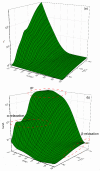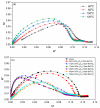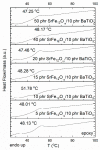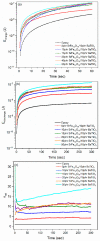Multifunctional Performance of Hybrid SrFe12O19/BaTiO3/Epoxy Resin Nanocomposites
- PMID: 36432944
- PMCID: PMC9696728
- DOI: 10.3390/polym14224817
Multifunctional Performance of Hybrid SrFe12O19/BaTiO3/Epoxy Resin Nanocomposites
Abstract
Polymer matrix nanocomposites are widely studied because of the versatility of their physical and mechanical properties. When these properties are present simultaneously, responding at relative stimuli, multifunctional performance is achieved. In this study, hybrid nanocomposites of SrFe12O19 and BaTiO3 ceramic particles dispersed in an epoxy resin matrix were fabricated and characterized. The content of SrFe12O19 was varying, while the amount of BaTiO3 was kept constant. The successful fabrication of the nanocomposites and the fine dispersion of the ceramic particles was verified via the morphological and structural characterization carried out with X-ray Diffraction patterns and Scanning Electron Microscopy images. Dielectric response and related relaxation phenomena were studied by means of Broadband Dielectric Spectroscopy. Dielectric permittivity augments with filler content, while the recorded relaxations, with descending relaxation time, are: (i) interfacial polarization, (ii) glass-to-rubber transition, (iii) intermediate dipolar effect, and (iv) re-orientation of polar-side groups of the main polymer chain. SrFe12O19 nanoparticles induce magnetic properties to the nanocomposites, which alter with the magnetic filler content. Static and dynamic mechanical response improves with filler content. Thermogravimetric analysis shown that ceramic particles are beneficial to the nanocomposites' thermal stability. Glass transition temperature, determined via Differential Scanning Calorimetry, was found to slightly vary with filler content, in accordance with the results from dynamic mechanical and dielectric analysis, indicating the effect of interactions occurring between the constituents. Examined systems are suitable for energy storing/retrieving.
Keywords: dielectric properties; hybrid nanocomposites; magnetic response; multifunctionality; thermomechanical behavior.
Conflict of interest statement
The authors declare no conflict of interest.
Figures
















References
-
- Song K., Guo J.Z., Liu C. Polymer-Based Multifunctional Nanocomposites and Their Applications. Elsevier; Amsterdam, The Netherlands: 2019.
-
- Friedrich K. Routes for achieving multifunctionality in reinforced polymers and composite structures. In: Friedrich K., Breuer U., editors. Multifunctionality of Polymer Composites. Elsevier; Amsterdam, The Netherlands: 2015. pp. 3–41.
-
- Krawczak P. Polymer composites: Evolve towards multifunctionality or perish. eXPRESS Polym. Lett. 2019;13:771. doi: 10.3144/expresspolymlett.2019.65. - DOI
-
- Psarras G.C. Ceramic/Polymer Nanodielectrics: Towards A Multifunctional or Smart Performance; Proceedings of the ECCM18—18th European Conference on Composite Materials; Athens, Greece. 24–28 June 2018; pp. 24–28.
-
- Bafakeeh O.T., Shewakh W.M., Abu-Oqail A., Abd-Elaziem W., Ghafaar M.A., Bakafeeh M.A.-O. Synthesis and Characterization of Hybrid Fiber-Reinforced Polymer by Adding Ceramic Nanoparticles for Aeronautical Structural Applications. Polymers. 2021;13:4116. doi: 10.3390/polym13234116. - DOI - PMC - PubMed
Grants and funding
LinkOut - more resources
Full Text Sources

